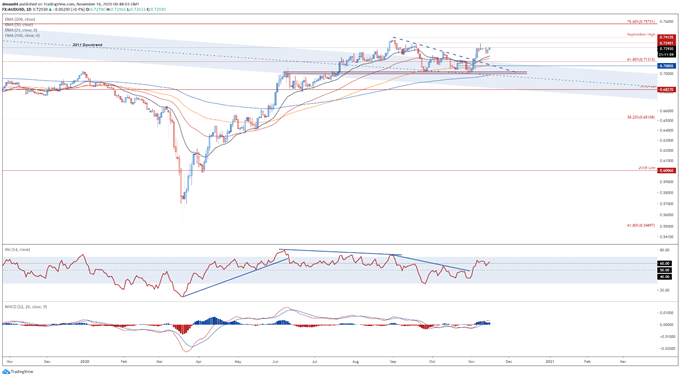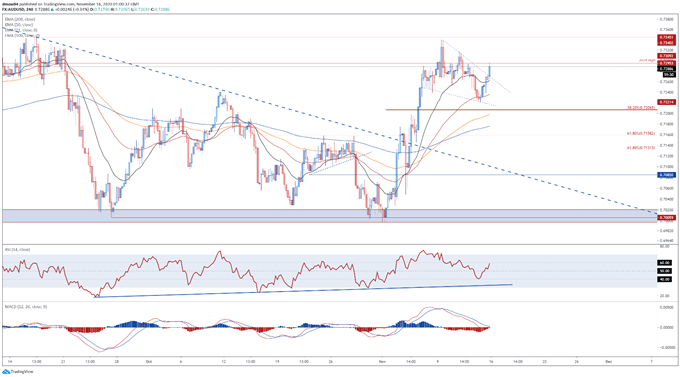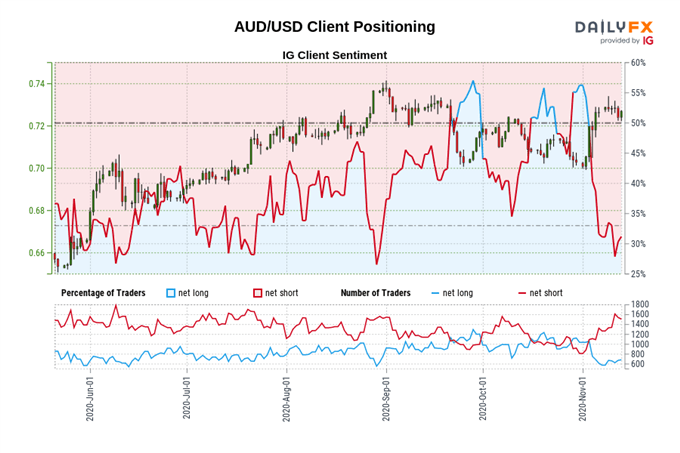Australian Dollar, AUD/USD, Chinese Economic Data, RCEP – Talking Points:
- The Chinese economy’s robust recovery from the February doldrums may continue to underpin AUD.
- Australia-China trade tensions may ease in the near term after the signing of the RCEP.
- AUD/USD eyeing a push to yearly highs after breaching key resistance.
Robust Chinese Recovery to Underpin AUD
China’s robust economic recovery from the February doldrums may continue to underpin the trade-sensitive Australian Dollar in the medium term.
Indeed, recent fundamental data releases suggest that the nation’s recovery is gathering pace, after the Caixin manufacturing, services and composite PMI prints for October exceeded market expectations.
The rate of growth in overall business activity was the joint-quickest in just under a decade, supported by strong manufacturing production and services activity.
Moreover, industrial production increased by 6.9% year-on-year last month, surpassing consensus estimates and climbing the most since December 2019.
China Industrial Production

The Chinese government is also yet to unleash trillions of yuan in stimulus, which suggests that a more extensive recovery could be in the offing.
Beijing ordered regional governments to sell 3.75 trillion yuan of bonds by the end of October, building on the 2.27 trillion sold in July and surpassing the total amount of debt issued in 2019.
Therefore, with a substantial fiscal safety-net in place it appears the world’s second-largest economy is set to continue expanding this year, which may ultimately buoy regional risk appetite and in turn put a premium on the cyclically-sensitive AUD.
RCEP to Soothe Australia-China Tensions
As noted in previous reports, escalating Australia-China trade tensions may prove to be a major headwind for the Aussie Dollar and regional risk assets.
Chinese Foreign Ministry spokesman Wang Wenbin stated that Australia’s “inflammatory comments on China’s domestic matters relating to Hong Kong, Xinjiang, and Taiwan”, and the violation of “usual diplomatic practices” in international relations, has “poisoned bilateral relations, and undermined the principles of Sino-Australian cooperation”.
However, the signing of the world’s largest regional free-trade agreement could soothe relations, as the Australian government attempts to pull Beijing back into multilateral negotiations and end the tit-for-tat exchanges that have threatened over $20 billion of exports.
Member Countries of the RCEP

Source – Asia Times
Officials from 15 Asia-Pacific nations penned the Regional Comprehensive Economic Partnership (RCEP) on the final day of the 37th Asean Summit on Sunday. The trade pact is expected to reduce tariffs, strengthen supply chains and implement new e-commerce regulations.
Australian Trade Minister Simon Birmingham believes that the RCEP will provide a platform to mend relations, stating that “I think these are times of tension between the two great powers and the more we can use the existing architectures for dialogue at an economic or security level, the better”.
Of course, it is yet to be seen if this historic free-trade agreement will prove successful in repairing Sino-Australian relations. Nevertheless, the potential for constructive dialogue could firm regional market sentiment and buoy risk-sensitive assets.
AUD/USD Daily Chart – Eyeing Yearly High

AUD/USD daily chart created using TradingView
The technical outlook for AUD/USD remains skewed to the topside as price continue to track firmly above all four moving averages and key psychological support at the 0.7200 mark.
With the RSI eyeing a push into overbought territory and the MACD indicator climbing to its highest levels since mid-September, the path of least resistance appears to favour the upside.
A daily close above the November 9 high (0.7340) may invite follow-through and carve a path to challenge the September high (0.7413). Breaking through that would probably bring the 78.6% Fibonacci (0.7573) into focus.
Alternatively, breaching support at the 21-day moving average (0.7196) could inspire would-be sellers and ignite a pullback towards the 61.8% Fibonacci (0.7131).
AUD/USD 4-Hour Chart – Break of Falling Wedge Hints at Gains

AUD/USD 4-hour chart created using TradingView
Zooming into a four-hour chart bolsters the bullish outlook depicted on the monthly timeframe, as price breaks above Falling Wedge resistance.
A bullish crossover on the MACD indicator, in tandem with the steepening slope of the RSI, is indicative of swelling buying pressure.
Breaching the 2019 high (0.7295) would probably signal the resumption of the uptrend extending from the monthly low (0.6991) and open the door for AUD/USD to challenge the resistance range at 0.7340 – 0.7350.
Pushing through that would likely see price begin to probe key resistance at the September high (0.7413).
Conversely, slipping back below support at the 21-DMA (0.7263) could generate a pullback to the November 13 low (0.7221).

Retail trader data shows 31.64% of traders are net-long with the ratio of traders short to long at 2.16 to 1. The number of traders net-long is 4.64% higher than yesterday and 9.92% higher from last week, while the number of traders net-short is 8.07% lower than yesterday and 7.21% higher from last week.
We typically take a contrarian view to crowd sentiment, and the fact traders are net-short suggests AUD/USD prices may continue to rise.
Yet traders are less net-short than yesterday and compared with last week. Recent changes in sentiment warn that the current AUD/USD price trend may soon reverse lower despite the fact traders remain net-short.
-- Written by Daniel Moss, Analyst for DailyFX
Follow me on Twitter @DanielGMoss








